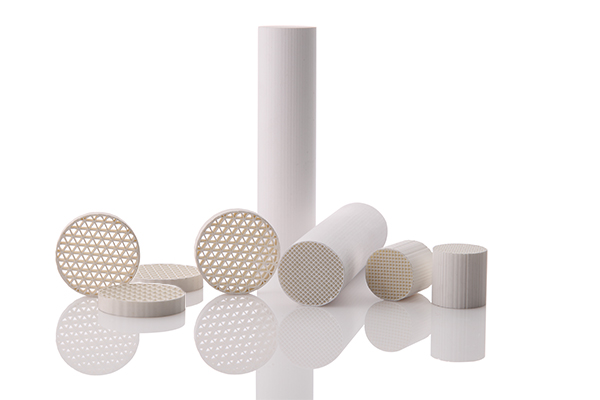Ceramic Honeycomb
Ceramic Honeycomb
- Diameter – 10mm to 600 mm
- Height – 10mm to 400 mm
- Open frontal area – 70%
- Cell density (cpsi) – 50, 100, 200, 300, 400 and 600
- Shape – Cylindrical or Cuboidal
- Compressive Strength: ≥10Mpa
- Porosity: ≥45%
- Maximum Use Temperature: ≥1100℃
- CTE(25℃~800℃): ≤1.8*10 -6 cm/cm/℃
- The average of pore diameter: 7-10μm
- Hydraulic channel Diameter: 1.1 mm
- Geometric surface area: 852 ft2/ft3
- Wall thickness: 0.15 mm
Full Description of Ceramic Honeycomb
The ceramic honeycomb is the pinnacle of ceramic product development today. Since it made in a single piece, hence it is also known as the ceramic monolith. The massive leaps in technological advancements have enabled us to design and develop highly refined ceramic honeycomb substrate which can have porous holes in it, from 20 to 40 holes/sq cm.
Apart from being an efficient filter, the honeycomb structure of the walls also makes this material considerably strong, with an overall increased surface area. It provides extensive thermal shock resistance. The hexagonal arrangement of the holes gives it incredible endurance and withstands significant rough use. Mainly there are square shaped holes in ceramic honeycomb having very thin wall thickness. Because of the thin wall thickness, the open frontal area is large and which reduce the back pressure of exhaust air.
Application Area of Ceramic Honeycomb
The ceramic honeycomb widely used as an extruded substrate in vehicle catalytic converters. The ceramic monolith is increasingly used in the automotive industry and other stationary emission devices, such as industrial machinery, as an efficient emission filter. Majorly it is used in exhaust control applications, where it employed as a substrate for three-way catalytic converter and Diesel particulate filter (DPF). Apart from this, it also used in individual reactors which operated in the chemical industry.
Its unique structure allows it to be widely used in numerous filtering processes, required in various industries, such as automotive, aerospace, etc. However, with the advances in ceramic technology, the ceramic filter is finding unlimited potential in other sectors as well, including electric power, chemical, petroleum, electronics, electrical appliances, etc.
Chemical Composition of Ceramic Honeycomb
The ceramic honeycomb conventionally made from kaolin, talc, aluminum powder, and clay. Today, you can get additional properties in these with the addition of zeolites and other refractory materials.
- Material of construction (MOC):
- Cordierite
- Cordierite Chemical Composition:
- Al2O3 : 35.2±1.5%
- SiO2 : 50.9±1.5%
- MgO : 13.9±1.5%
Download Resources
Why Techinstro
Techinstro has been designing and manufacture top-end ceramic filters for many years. We also customized the products as per client need. We supply this material to research laboratories and extensively for automotive industries. The company ensures optimum quality of all its products through stringent quality control methods and regulations to get the best range of ceramic honeycomb.

